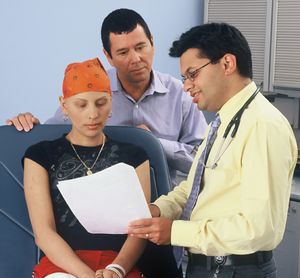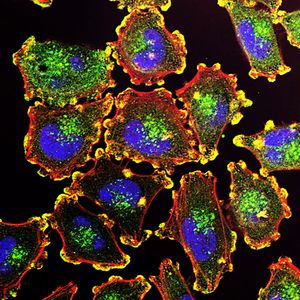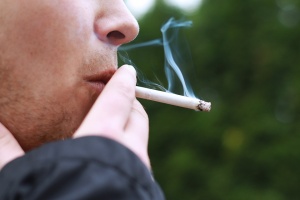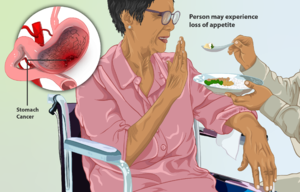Oncology: Difference between revisions
No edit summary |
No edit summary |
||
| (44 intermediate revisions by 8 users not shown) | |||
| Line 1: | Line 1: | ||
<div class="editorbox"> | <div class="editorbox"> | ||
'''Original Editor '''- | '''Original Editor '''- [[User:Elaine Lonnemann|Elaine Lonnemann]] | ||
''' | '''Top Contributors''' - {{Special:Contributors/{{FULLPAGENAME}}}} | ||
</div> | </div> | ||
== | == Introduction == | ||
< | [[File:National-cancer-institute-0YBIMOqQzt0-unsplash.jpg|right|frameless]] | ||
< | Oncology is a branch of medicine that specialises in the diagnosis and treatment of cancer. It includes | ||
</ | * Medical oncology (the use of [[Chemotherapy Side Effects and Syndromes|chemotherapy]], [[immunotherapy]], [[Hormones|hormone]] therapy, and other drugs to treat cancer), | ||
* [[Radiation Side Effects and Syndromes|Radiation]] oncology (the use of radiation therapy to treat cancer) | |||
* Surgical oncology (the use of surgery and other procedures to treat cancer)<ref>NCI [https://www.cancer.gov/publications/dictionaries/cancer-terms/def/oncology Cancer] Available from:https://www.cancer.gov/publications/dictionaries/cancer-terms/def/oncology (last accessed 29.8.2020)</ref>. | |||
Cancer is the second leading cause of death globally | |||
* Responsible for an estimated 9.6 million deaths in 2018. Globally, about 1 in 6 deaths is due to cancer. | |||
* Approximately 70% of deaths from cancer occur in low- and middle-income countries. | |||
* Around one third of deaths from cancer are due to the 5 leading behavioral and dietary risks: high [[Body Mass Index|body mass index]], low fruit and vegetable intake, lack of [[Physical Activity|physical activity]], tobacco use, and alcohol use<ref>WHO [https://www.who.int/news-room/fact-sheets/detail/cancer Cancer] Available from:https://www.who.int/news-room/fact-sheets/detail/cancer (last accessed29.8.2020)</ref>. | |||
Physiotherapy are involved in care, management and rehabilitation of cancer patients from diagnosis to the [[Palliative Care Competence Framework for Physiotherapists|end of life]]. They: | |||
* Conduct ongoing assessment of the needs of this patient group and their carers, in order to apply skilled interventions, which are vital for patients’ independence, functional capacity and quality of life. | |||
* Are an essential member of the multi-disciplinary team, which is the key to successful rehabilitation and management of patients with cancer and [[Physiotherapy in Palliative Care|palliative]] care. | |||
* The absence of physiotherapy intervention would be detrimental to patient care and the ability of the patient/family to cope with the effects of the disease or its treatment on their functional capacity and [[Quality of Life|quality of life]]<ref>The Role of Physiotherapy for People with Cancer - CSP Position Statement. The Chartered Society of Physiotherapy, July 2003. Available at http://www.csp.org.uk/uploads/documents/csp_statement_physioandcancer.pdf. Retrieved 10/7/2010</ref>. | |||
The following 5 minutes video is entitled "What causes cancer and how is it treated"<br>{{#ev:youtube|https://www.youtube.com/watch?v=SGaQ0WwZ_0I|width}}<ref>CTCA What is cancer Available from:https://www.youtube.com/watch?v=SGaQ0WwZ_0I (last accessed 29.8.2020)</ref> | |||
== Pathophysiology == | |||
[[File:National-cancer-institute-sIqWYiNLiJU-unsplash.jpg|right|frameless]] | |||
Oncology is the branch of medicine that involves the prevention, diagnosis, treatment, and study of cancer. | |||
Cancer describes the abnormal growth of cells that results in a large mass known as a tumour. | |||
* Malignant tumours can spread into and invade surrounding tissues and in some cases the cells can break off and travel to other areas of the body, which is known as metatstasis. | |||
* Benign tumours do not invade surrounding tissues and do not continue to grow once they have been removed. | |||
* The regulation of cells is controlled by genetics and it takes changes to genes to create abnormal cancerous cells. | |||
* Genetic changes can be due to either the loss or gain of chromosomes through mitosis (the process of cell duplication) or due to mutations, changes in the nucleotide sequence of genomic DNA. | |||
< | == Causes == | ||
[[File:Smoking-1026556 960 720-2.jpg|right|frameless]] | |||
There are several causes of cancer, the most common being genetic mutations due to environmental and lifestyle factors, which account for between 90-95% of cases. The remaining are due to inherited genetics<ref>Anand P, Kunnumakara AB, Sundaram C, Harikumar KB, Tharakan ST, Lai OS, Sung B, Aggarwal BB. Cancer is a preventable disease that requires major lifestyle changes. Pharmaceutical research. 2008 Sep 1;25(9):2097-116.</ref>. There are many known environmental factors that increase the risk of developing cancer: | |||
* '''Carcinogens''': There are many known carcinogens with the most obvious one being tobacco. | |||
* Tobacco: Each year tobacco is responsible for than 7 million deaths worldwide, more than 6 million of those can be attributed to direct tobacco use, but there are approximately 890,000 that are the result of second-hand tobacco smoke<ref>World Health Organization. Tobacco [Internet]. Geneva: World Health Organization; March 2018 [cited 21 May 2019]. Available from: https://www.who.int/news-room/fact-sheets/detail/tobacco</ref>. Recent decreases in the numbers of people smoking has led to a decrease, in many countries, of cancer deaths related to [[Lung Cancer|lung cancer]] 1990.<ref>Islami F, Torre LA, Jemal A. Global trends of lung cancer mortality and smoking prevalence. Translational lung cancer research. 2015 Aug;4(4):327.</ref> | |||
* '''Radiation''': Radiation has long been known to be carcinogenic. Initially studies focused on incidents that involve large amounts of radiation and it was evident that large doses of radiation were at a higher risk of developing cancer.<ref>Ron, E. (1998). ''Ionizing Radiation and Cancer Risk: Evidence from Epidemiology. Radiation Research, 150(5)''</ref> It is now known that even low doses of radiation emitted by an X-ray machine can put a person at risk, especially if exposure starts young and is repeated often.<ref>Kleinerman RA. Cancer risks following diagnostic and therapeutic radiation exposure in children. Pediatric radiology. 2006 Sep 1;36(2):121-5.</ref> | |||
* '''Pollution''': Air pollution has been identified as a contributing risk factor for developing cancer and also for lowering the rates of a positive prognosis <ref>Vineis, P., & Husgafvel-Pursiainen, K. (2005). ''Air pollution and cancer: biomarker studies in human populations †. Carcinogenesis, 26(11), 1846–1855.''doi:10.1093/carcin/bgi216 </ref> | |||
* '''[[Nutrition|Diet]], [[Therapeutic Exercise|Exercise]] and [[Obesity]]''': Obesity has been recognised as a contributing factor, in relation, to cancer; both in terms of risk and mortality.<ref>Ligibel JA, Alfano CM, Courneya KS, Demark-Wahnefried W, Burger RA, Chlebowski RT, Fabian CJ, Gucalp A, Hershman DL, Hudson MM, Jones LW. American Society of Clinical Oncology position statement on obesity and cancer. Journal of clinical oncology. 2014 Nov 1;32(31):3568.</ref> As well as controlling obesity diet an exercise also have role to play in preventing and managing cancer. The World Health Organisation estimated a 20% to 40% decrease in the risk of developing [[Breast Cancer|breast cancer]] amongst physically active women.<ref>Bianchini F, Kaaks R, Vainio H. Weight control and physical activity in cancer prevention. Obes Rev. 2002; 3:5-8.</ref> And in another study, published in 2008, a group of 2987 women participated in a study, via questionnaire, that showed physical activity was associated with an improved prognosis.<ref>Holmes MD, Chen WY, Feskanich D, Kroenke CH, Colditz GA. Physical activity and survival after breast cancer diagnosis. Jama. 2005 May 25;293(20):2479-86.</ref> As much as [[Physical Activity|physical activity]] can have a positive effect on preventing and improving prognosis, lack of physical activity can be detrimental | |||
* '''[[Infectious Disease|Infections]]''': It has long been recognised that infections are a cause of cancer and in 2002 it was estimated that approximately 18% of of malignant cancers could be attributed to an infection.<ref>Parkin DM. The global health burden of infection-associated cancers in the year 2002. Int J Cancer 2006;118:3030–44</ref> | |||
* '''[[Stress and Health|Stress]]''': There is evidence that stress has a detrimental effect on the immune response and may be a contributing factor to the initiation and in some cases progression of cancer.<ref>Reiche, E. M. V., Nunes, S. O. V., & Morimoto, H. K. (2004). ''Stress, depression, the immune system, and cancer. The Lancet Oncology, 5(10), 617–625.'' doi:10.1016/s1470-2045(04)01597-9</ref> | |||
== Conditions == | == Conditions == | ||
[[File:Stomach cancer patient.png|right|frameless]] | |||
[ | There are many types of cancer, see below: | ||
*[[Acute Lymphoblastic Leukemia|Acute Lymphoblastic Leukemia]] | |||
*[[Acute Myeloid Leukemia|Acute Myeloid Leukemia]] | |||
*[[Brain Tumors]] | |||
*[[Breast Cancer|Breast Cancer]] | |||
*[[Cervical Cancer|Cervical Cancer]] | |||
*[[Chondroblastoma|Chondroblastoma]] | |||
*[[Colorectal Cancer|Colorectal Cancer]] | |||
*[[Ewing's Sarcoma|Ewing's Sarcoma]] | |||
*[[Gastric Cancer|Gastric Cancer]] | |||
*[[Giant Cell Tumor|Giant Cell Tumor]] | |||
*[[Glioblastoma Multiforme|Glioblastoma Multiforme]] | |||
*[[Hodgkin's Lymphoma]] | |||
*[http://www.physio-pedia.com/Malignant_Melanoma Malignant Melanoma] | |||
*[[Multiple Myeloma|Multiple Myeloma]] | |||
*[[Neuroblastoma]] | |||
*[[File:Breast Cancer Metastases Diagram1 .jpg|right|frameless]][[Non Hodgkin Lymphoma|Non Hodgkin Lymphoma]] | |||
*[[Osteoblastoma|Osteoblastoma]] | |||
*[[Osteochondroma]] | |||
*[[Osteoid Osteoma]] | |||
*[[Osteosarcoma]] | |||
*[[Pancreatic Cancer|Pancreatic Cancer]] | |||
*[http://www.physio-pedia.com/Paraneoplastic_Syndrome Paraneoplastic Syndrome] | |||
*[[Renal Cancer]] | |||
*[[Skeletal Metastases|Skeletal Metastases]] | |||
*[[Testicular Cancer|Testicular Cancer]] | |||
*[[Thyroid Cancer|Thyroid Cancer]] | |||
== Examination == | == Examination == | ||
*[[Oncology Examination]] | |||
== Interventions == | |||
*[[Oncology Medical Management|Medical Management]] | |||
*[[Oncology Physiotherapy Management|Physiotherapy Management]] | |||
*[[Radiation Side Effects and Syndromes|Radiation Side Effects and Syndromes]] | |||
*[[Chemotherapy Side Effects & Syndromes|Chemotherapy Side Effects & Syndromes]] | |||
== Outcome Measures == | |||
[https://physio-pedia.com/Visual_Analogue_Scale Visual Analogue Scale (VAS)] | |||
[https://physio-pedia.com/Quality_of_Life Quality of Life Questionnaire (QoL)] | |||
European Organisation for the Research and Treatment of Cancer Quality of Life Questionnaire Core-30 (EORTC QLQ-C30)<ref>Aaronson NK, Ahmedzai S, Bergman B, et al. The European Organization for Research and Treatment of Cancer QLQ-C30: a quality-of-life instrument for use in international clinical trials in oncology. J Natl Cancer Inst 1993;85:365–76.</ref> | |||
Functional Assessment of Cancer and Therapy – General measure (FACT-G)<ref>Cella DF, Tulsky DS, Gray G, et al. The Functional Assessment of Cancer Therapy scale: development and validation of the general measure. J Clin Oncol 1993;11:570–9</ref> | |||
== References == | == References == | ||
<references /> | |||
[[Category:Oncology]] | |||
{| width="100%" cellspacing="1" cellpadding="1" | |||
|- | |||
|} | |||
Latest revision as of 07:31, 19 January 2023
Original Editor - Elaine Lonnemann
Top Contributors - Elaine Lonnemann, Admin, Lucinda hampton, Fasuba Ayobami, Kim Jackson, Rachael Lowe, George Prudden, WikiSysop and Nicole Hills
Introduction[edit | edit source]
Oncology is a branch of medicine that specialises in the diagnosis and treatment of cancer. It includes
- Medical oncology (the use of chemotherapy, immunotherapy, hormone therapy, and other drugs to treat cancer),
- Radiation oncology (the use of radiation therapy to treat cancer)
- Surgical oncology (the use of surgery and other procedures to treat cancer)[1].
Cancer is the second leading cause of death globally
- Responsible for an estimated 9.6 million deaths in 2018. Globally, about 1 in 6 deaths is due to cancer.
- Approximately 70% of deaths from cancer occur in low- and middle-income countries.
- Around one third of deaths from cancer are due to the 5 leading behavioral and dietary risks: high body mass index, low fruit and vegetable intake, lack of physical activity, tobacco use, and alcohol use[2].
Physiotherapy are involved in care, management and rehabilitation of cancer patients from diagnosis to the end of life. They:
- Conduct ongoing assessment of the needs of this patient group and their carers, in order to apply skilled interventions, which are vital for patients’ independence, functional capacity and quality of life.
- Are an essential member of the multi-disciplinary team, which is the key to successful rehabilitation and management of patients with cancer and palliative care.
- The absence of physiotherapy intervention would be detrimental to patient care and the ability of the patient/family to cope with the effects of the disease or its treatment on their functional capacity and quality of life[3].
The following 5 minutes video is entitled "What causes cancer and how is it treated"
Pathophysiology[edit | edit source]
Oncology is the branch of medicine that involves the prevention, diagnosis, treatment, and study of cancer. Cancer describes the abnormal growth of cells that results in a large mass known as a tumour.
- Malignant tumours can spread into and invade surrounding tissues and in some cases the cells can break off and travel to other areas of the body, which is known as metatstasis.
- Benign tumours do not invade surrounding tissues and do not continue to grow once they have been removed.
- The regulation of cells is controlled by genetics and it takes changes to genes to create abnormal cancerous cells.
- Genetic changes can be due to either the loss or gain of chromosomes through mitosis (the process of cell duplication) or due to mutations, changes in the nucleotide sequence of genomic DNA.
Causes[edit | edit source]
There are several causes of cancer, the most common being genetic mutations due to environmental and lifestyle factors, which account for between 90-95% of cases. The remaining are due to inherited genetics[5]. There are many known environmental factors that increase the risk of developing cancer:
- Carcinogens: There are many known carcinogens with the most obvious one being tobacco.
- Tobacco: Each year tobacco is responsible for than 7 million deaths worldwide, more than 6 million of those can be attributed to direct tobacco use, but there are approximately 890,000 that are the result of second-hand tobacco smoke[6]. Recent decreases in the numbers of people smoking has led to a decrease, in many countries, of cancer deaths related to lung cancer 1990.[7]
- Radiation: Radiation has long been known to be carcinogenic. Initially studies focused on incidents that involve large amounts of radiation and it was evident that large doses of radiation were at a higher risk of developing cancer.[8] It is now known that even low doses of radiation emitted by an X-ray machine can put a person at risk, especially if exposure starts young and is repeated often.[9]
- Pollution: Air pollution has been identified as a contributing risk factor for developing cancer and also for lowering the rates of a positive prognosis [10]
- Diet, Exercise and Obesity: Obesity has been recognised as a contributing factor, in relation, to cancer; both in terms of risk and mortality.[11] As well as controlling obesity diet an exercise also have role to play in preventing and managing cancer. The World Health Organisation estimated a 20% to 40% decrease in the risk of developing breast cancer amongst physically active women.[12] And in another study, published in 2008, a group of 2987 women participated in a study, via questionnaire, that showed physical activity was associated with an improved prognosis.[13] As much as physical activity can have a positive effect on preventing and improving prognosis, lack of physical activity can be detrimental
- Infections: It has long been recognised that infections are a cause of cancer and in 2002 it was estimated that approximately 18% of of malignant cancers could be attributed to an infection.[14]
- Stress: There is evidence that stress has a detrimental effect on the immune response and may be a contributing factor to the initiation and in some cases progression of cancer.[15]
Conditions[edit | edit source]
There are many types of cancer, see below:
- Acute Lymphoblastic Leukemia
- Acute Myeloid Leukemia
- Brain Tumors
- Breast Cancer
- Cervical Cancer
- Chondroblastoma
- Colorectal Cancer
- Ewing's Sarcoma
- Gastric Cancer
- Giant Cell Tumor
- Glioblastoma Multiforme
- Hodgkin's Lymphoma
- Malignant Melanoma
- Multiple Myeloma
- Neuroblastoma
- Non Hodgkin Lymphoma
- Osteoblastoma
- Osteochondroma
- Osteoid Osteoma
- Osteosarcoma
- Pancreatic Cancer
- Paraneoplastic Syndrome
- Renal Cancer
- Skeletal Metastases
- Testicular Cancer
- Thyroid Cancer
Examination[edit | edit source]
Interventions[edit | edit source]
- Medical Management
- Physiotherapy Management
- Radiation Side Effects and Syndromes
- Chemotherapy Side Effects & Syndromes
Outcome Measures[edit | edit source]
Quality of Life Questionnaire (QoL)
European Organisation for the Research and Treatment of Cancer Quality of Life Questionnaire Core-30 (EORTC QLQ-C30)[16]
Functional Assessment of Cancer and Therapy – General measure (FACT-G)[17]
References[edit | edit source]
- ↑ NCI Cancer Available from:https://www.cancer.gov/publications/dictionaries/cancer-terms/def/oncology (last accessed 29.8.2020)
- ↑ WHO Cancer Available from:https://www.who.int/news-room/fact-sheets/detail/cancer (last accessed29.8.2020)
- ↑ The Role of Physiotherapy for People with Cancer - CSP Position Statement. The Chartered Society of Physiotherapy, July 2003. Available at http://www.csp.org.uk/uploads/documents/csp_statement_physioandcancer.pdf. Retrieved 10/7/2010
- ↑ CTCA What is cancer Available from:https://www.youtube.com/watch?v=SGaQ0WwZ_0I (last accessed 29.8.2020)
- ↑ Anand P, Kunnumakara AB, Sundaram C, Harikumar KB, Tharakan ST, Lai OS, Sung B, Aggarwal BB. Cancer is a preventable disease that requires major lifestyle changes. Pharmaceutical research. 2008 Sep 1;25(9):2097-116.
- ↑ World Health Organization. Tobacco [Internet]. Geneva: World Health Organization; March 2018 [cited 21 May 2019]. Available from: https://www.who.int/news-room/fact-sheets/detail/tobacco
- ↑ Islami F, Torre LA, Jemal A. Global trends of lung cancer mortality and smoking prevalence. Translational lung cancer research. 2015 Aug;4(4):327.
- ↑ Ron, E. (1998). Ionizing Radiation and Cancer Risk: Evidence from Epidemiology. Radiation Research, 150(5)
- ↑ Kleinerman RA. Cancer risks following diagnostic and therapeutic radiation exposure in children. Pediatric radiology. 2006 Sep 1;36(2):121-5.
- ↑ Vineis, P., & Husgafvel-Pursiainen, K. (2005). Air pollution and cancer: biomarker studies in human populations †. Carcinogenesis, 26(11), 1846–1855.doi:10.1093/carcin/bgi216
- ↑ Ligibel JA, Alfano CM, Courneya KS, Demark-Wahnefried W, Burger RA, Chlebowski RT, Fabian CJ, Gucalp A, Hershman DL, Hudson MM, Jones LW. American Society of Clinical Oncology position statement on obesity and cancer. Journal of clinical oncology. 2014 Nov 1;32(31):3568.
- ↑ Bianchini F, Kaaks R, Vainio H. Weight control and physical activity in cancer prevention. Obes Rev. 2002; 3:5-8.
- ↑ Holmes MD, Chen WY, Feskanich D, Kroenke CH, Colditz GA. Physical activity and survival after breast cancer diagnosis. Jama. 2005 May 25;293(20):2479-86.
- ↑ Parkin DM. The global health burden of infection-associated cancers in the year 2002. Int J Cancer 2006;118:3030–44
- ↑ Reiche, E. M. V., Nunes, S. O. V., & Morimoto, H. K. (2004). Stress, depression, the immune system, and cancer. The Lancet Oncology, 5(10), 617–625. doi:10.1016/s1470-2045(04)01597-9
- ↑ Aaronson NK, Ahmedzai S, Bergman B, et al. The European Organization for Research and Treatment of Cancer QLQ-C30: a quality-of-life instrument for use in international clinical trials in oncology. J Natl Cancer Inst 1993;85:365–76.
- ↑ Cella DF, Tulsky DS, Gray G, et al. The Functional Assessment of Cancer Therapy scale: development and validation of the general measure. J Clin Oncol 1993;11:570–9











